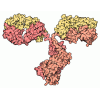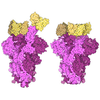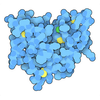[English] 日本語
 Yorodumi
Yorodumi- PDB-9b13: Cryo-EM structure of phospholipase Cepsilon PH-COOH in complex wi... -
+ Open data
Open data
- Basic information
Basic information
| Entry | Database: PDB / ID: 9b13 | |||||||||||||||||||||
|---|---|---|---|---|---|---|---|---|---|---|---|---|---|---|---|---|---|---|---|---|---|---|
| Title | Cryo-EM structure of phospholipase Cepsilon PH-COOH in complex with an antigen-binding fragment (composite structure) | |||||||||||||||||||||
 Components Components |
| |||||||||||||||||||||
 Keywords Keywords | MEMBRANE PROTEIN / phospholipase c / antigen-binding fragment / complex | |||||||||||||||||||||
| Function / homology |  Function and homology information Function and homology informationdiacylglycerol biosynthetic process / Synthesis of IP3 and IP4 in the cytosol / phosphoinositide phospholipase C / phosphatidylinositol metabolic process / phospholipase C activity / phosphatidylinositol-4,5-bisphosphate phospholipase C activity / glomerulus development / phosphatidylinositol-mediated signaling / lipid catabolic process / positive regulation of lamellipodium assembly ...diacylglycerol biosynthetic process / Synthesis of IP3 and IP4 in the cytosol / phosphoinositide phospholipase C / phosphatidylinositol metabolic process / phospholipase C activity / phosphatidylinositol-4,5-bisphosphate phospholipase C activity / glomerulus development / phosphatidylinositol-mediated signaling / lipid catabolic process / positive regulation of lamellipodium assembly / release of sequestered calcium ion into cytosol / guanyl-nucleotide exchange factor activity / small GTPase binding / epidermal growth factor receptor signaling pathway / lamellipodium / phospholipase C-activating G protein-coupled receptor signaling pathway / Ras protein signal transduction / intracellular signal transduction / G protein-coupled receptor signaling pathway / Golgi membrane / enzyme binding / metal ion binding / plasma membrane / cytosol Similarity search - Function | |||||||||||||||||||||
| Biological species |   Homo sapiens (human) Homo sapiens (human) | |||||||||||||||||||||
| Method | ELECTRON MICROSCOPY / single particle reconstruction / cryo EM / Resolution: 3.9 Å | |||||||||||||||||||||
 Authors Authors | Samassekou, K. / Lyon, A.M. | |||||||||||||||||||||
| Funding support |  United States, 2items United States, 2items
| |||||||||||||||||||||
 Citation Citation |  Journal: Commun Biol / Year: 2025 Journal: Commun Biol / Year: 2025Title: Cryo-EM structure of phospholipase Cε defines N-terminal domains and their roles in activity. Authors: Kadidia Samassekou / Elisabeth E Garland-Kuntz / Vaani Ohri / Isaac J Fisher / Satchal K Erramilli / Kaushik Muralidharan / Livia M Bogdan / Abigail M Gick / Anthony Kossiakoff / Angeline M Lyon /  Abstract: Phospholipase Cε (PLCε) increases intracellular Ca and protein kinase C (PKC) activity in the cardiovascular system in response to stimulation of G protein coupled receptors (GPCRs) and receptor ...Phospholipase Cε (PLCε) increases intracellular Ca and protein kinase C (PKC) activity in the cardiovascular system in response to stimulation of G protein coupled receptors (GPCRs) and receptor tyrosine kinases (RTKs). The ability of PLCε to respond to these diverse inputs is due, in part, to multiple, conformationally dynamic regulatory domains. However, this heterogeneity has limited structural studies of the lipase to either individual domains or its catalytic core. Here, we report the 3.9 Å reconstruction of the largest fragment of PLCε to date in complex with an antigen binding fragment (Fab). The structure reveals that PLCε contains a pleckstrin homology (PH) domain and four tandem EF hands, including subfamily-specific insertions and intramolecular interactions with the catalytic core. The structure, together with a model of the holoenzyme, suggest that part of the N-terminus and PH domain may form a surface that supports lipase activity. Functional characterization of this surface confirms it is critical for maximum basal and G protein-stimulated activities. This study provides new insights into the autoinhibited, basal conformation of PLCε and how the N-terminal domains contribute to activity. | |||||||||||||||||||||
| History |
|
- Structure visualization
Structure visualization
| Structure viewer | Molecule:  Molmil Molmil Jmol/JSmol Jmol/JSmol |
|---|
- Downloads & links
Downloads & links
- Download
Download
| PDBx/mmCIF format |  9b13.cif.gz 9b13.cif.gz | 254.8 KB | Display |  PDBx/mmCIF format PDBx/mmCIF format |
|---|---|---|---|---|
| PDB format |  pdb9b13.ent.gz pdb9b13.ent.gz | 189.3 KB | Display |  PDB format PDB format |
| PDBx/mmJSON format |  9b13.json.gz 9b13.json.gz | Tree view |  PDBx/mmJSON format PDBx/mmJSON format | |
| Others |  Other downloads Other downloads |
-Validation report
| Summary document |  9b13_validation.pdf.gz 9b13_validation.pdf.gz | 1.3 MB | Display |  wwPDB validaton report wwPDB validaton report |
|---|---|---|---|---|
| Full document |  9b13_full_validation.pdf.gz 9b13_full_validation.pdf.gz | 1.3 MB | Display | |
| Data in XML |  9b13_validation.xml.gz 9b13_validation.xml.gz | 51.5 KB | Display | |
| Data in CIF |  9b13_validation.cif.gz 9b13_validation.cif.gz | 75.7 KB | Display | |
| Arichive directory |  https://data.pdbj.org/pub/pdb/validation_reports/b1/9b13 https://data.pdbj.org/pub/pdb/validation_reports/b1/9b13 ftp://data.pdbj.org/pub/pdb/validation_reports/b1/9b13 ftp://data.pdbj.org/pub/pdb/validation_reports/b1/9b13 | HTTPS FTP |
-Related structure data
| Related structure data |  44064MC M: map data used to model this data C: citing same article ( |
|---|---|
| Similar structure data | Similarity search - Function & homology  F&H Search F&H Search |
| Experimental dataset #1 | Data reference:  10.6019/EMPIAR-12020 / Data set type: EMPIAR / Details: raw frames / Metadata reference: 10.6019/EMPIAR-12020 10.6019/EMPIAR-12020 / Data set type: EMPIAR / Details: raw frames / Metadata reference: 10.6019/EMPIAR-12020 |
- Links
Links
- Assembly
Assembly
| Deposited unit | 
|
|---|---|
| 1 |
|
- Components
Components
| #1: Protein | Mass: 165314.125 Da / Num. of mol.: 1 / Fragment: PH-C terminus, residues 837-2281 Source method: isolated from a genetically manipulated source Source: (gene. exp.)   References: UniProt: Q99P84, phosphoinositide phospholipase C |
|---|---|
| #2: Antibody | Mass: 28234.482 Da / Num. of mol.: 1 Source method: isolated from a genetically manipulated source Source: (gene. exp.)  Homo sapiens (human) / Production host: Homo sapiens (human) / Production host:  |
| #3: Antibody | Mass: 25794.859 Da / Num. of mol.: 1 Source method: isolated from a genetically manipulated source Source: (gene. exp.)  Homo sapiens (human) / Production host: Homo sapiens (human) / Production host:  |
| #4: Chemical | ChemComp-CA / |
| Has ligand of interest | Y |
| Has protein modification | Y |
-Experimental details
-Experiment
| Experiment | Method: ELECTRON MICROSCOPY |
|---|---|
| EM experiment | Aggregation state: PARTICLE / 3D reconstruction method: single particle reconstruction |
- Sample preparation
Sample preparation
| Component |
| |||||||||||||||||||||||||||||||||||
|---|---|---|---|---|---|---|---|---|---|---|---|---|---|---|---|---|---|---|---|---|---|---|---|---|---|---|---|---|---|---|---|---|---|---|---|---|
| Molecular weight |
| |||||||||||||||||||||||||||||||||||
| Source (natural) |
| |||||||||||||||||||||||||||||||||||
| Source (recombinant) |
| |||||||||||||||||||||||||||||||||||
| Buffer solution | pH: 8 | |||||||||||||||||||||||||||||||||||
| Buffer component |
| |||||||||||||||||||||||||||||||||||
| Specimen | Conc.: 0.6 mg/ml / Embedding applied: NO / Shadowing applied: NO / Staining applied: NO / Vitrification applied: YES | |||||||||||||||||||||||||||||||||||
| Specimen support | Grid material: COPPER / Grid mesh size: 300 divisions/in. / Grid type: Quantifoil R1.2/1.3 | |||||||||||||||||||||||||||||||||||
| Vitrification | Instrument: FEI VITROBOT MARK IV / Cryogen name: ETHANE / Humidity: 100 % / Chamber temperature: 277 K |
- Electron microscopy imaging
Electron microscopy imaging
| Experimental equipment |  Model: Titan Krios / Image courtesy: FEI Company |
|---|---|
| Microscopy | Model: FEI TITAN KRIOS |
| Electron gun | Electron source:  FIELD EMISSION GUN / Accelerating voltage: 300 kV / Illumination mode: FLOOD BEAM FIELD EMISSION GUN / Accelerating voltage: 300 kV / Illumination mode: FLOOD BEAM |
| Electron lens | Mode: BRIGHT FIELD / Nominal magnification: 81000 X / Nominal defocus max: 2000 nm / Nominal defocus min: 700 nm / Cs: 2.7 mm |
| Specimen holder | Cryogen: NITROGEN / Specimen holder model: FEI TITAN KRIOS AUTOGRID HOLDER |
| Image recording | Average exposure time: 3.2 sec. / Electron dose: 53.75 e/Å2 / Film or detector model: GATAN K3 (6k x 4k) / Num. of grids imaged: 1 / Num. of real images: 7052 |
- Processing
Processing
| CTF correction | Type: PHASE FLIPPING AND AMPLITUDE CORRECTION |
|---|---|
| Particle selection | Num. of particles selected: 1471782 |
| Symmetry | Point symmetry: C1 (asymmetric) |
| 3D reconstruction | Resolution: 3.9 Å / Resolution method: FSC 0.143 CUT-OFF / Num. of particles: 147120 / Symmetry type: POINT |
 Movie
Movie Controller
Controller





 PDBj
PDBj






